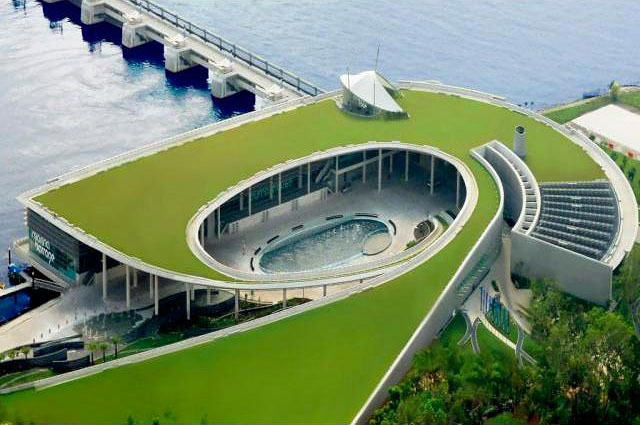
© www.memsys.eu Solar driven desalination at Marina Barrage, Singapore
.
The world's most densely populated country now collects rainwater from two-thirds of its land, recycles wastewater and is even developing technology that mimics human kidneys to desalinate seawater."In about a lifetime, we have transformed Singapore," said George Madhavan, an engineer who has worked for the national PUB water agency for 30 years and is now communications director.
"It's not rocket science - it is more political will ... The key success factor is really government - the leadership to pull different agencies together to come up with a plan ..."
As governments around the world wrestle with water crises from droughts to floods, many are looking to the tiny Asian city-state of Singapore for solutions.
In many countries, a flood prevention agency focuses on quickly draining away storm water, while another manages drinking water.
In Singapore, PUB "manages the entire water loop", Madhavan told the Thomson Reuters Foundation.
Its aim is to capture every drop of rain it can and recycle as much used water as possible.
"That means that ideally, we don't sell you water. We rent you water. We take it back, we clean it. We're like a laundry service. Then you can multiply your supply of water many, many times," Madhavan said.
"The water that you drink today is the same water that dinosaurs drank. We don't create or destroy water. It just goes around. So we are using engineering to shorten the loop."
BEWARE OF CROCODILES
Following independence on August 9, 1965, the new 700 sq km country relied on three reservoirs and water imported from neighbouring Malaysia.
Today, it collects rainwater through an 8,000-km drain network that empties into 17 reservoirs, and reclaims used water from a deep tunnel sewerage system up to 60 meters below ground.
Singapore, which is recognized as a global leader in water technology, set up a water planning unit in 1972. Unlike Bangkok, Kuala Lumpur and Tokyo, it does not have land outside the city to act as huge catchment areas.
Eleven government agencies joined up from 1977 to 1987 to clean the heavily polluted Singapore River and Kallang Basin in the main commercial area.
The city relocated 610 pig farms and 500 duck farms (later barring such farms), transferred 5,000 street hawkers to food centers, and moved boats east to the Pasir Panjang area.
Madhavan said the biggest challenge was relocating 46,000 squatters living in squalid conditions without sewers into housing blocks.More than 260 tonnes of rubbish were removed, the area was landscaped, and in 1987, fish returned to the waters.Worried about pollution, authorities initially kept people away from the waterways.
"We even had warning signs about crocodiles (which had been spotted in the reservoirs) to keep people away," Madhavan said.
Singapore has since shifted its stance, opening waterfront areas such as Marina Reservoir, where people kayak, bike and fly kites against a backdrop of the city's high rise skyline.HOLY GRAIL OF DESALINATION
Singapore's "four national taps" supply 400 million gallons each day for 5.4 million people.The island's two natural sources are rain and, through an agreement that expires in 2061, up to 250 million gallons per day from Malaysia's Johor River.
As climate change makes nature's sources less reliable, Singapore is focusing on its reclaimed and desalinated water taps.
NEWater, introduced in 2003, is the name for used water from the sewerage system, treated and further purified through microfiltration, reverse osmosis and ultraviolet disinfection.Meeting 30 percent of demand, NEWater is potable but mainly used by industries and during the dry season to top up reservoirs. Singapore aims for NEWater to meet 55 percent of demand by 2060.
The island's first desalination plant opened in 2005, and desalinated water meets a quarter of demand.
Desalinated water and NEWater are fairly independent of the weather but on the downside, require more energy to produce, Madhavan said.
Conventional reverse osmosis requires 3.5 to 4 kilowatt-hours (kWh) to squeeze seawater through a membrane to make 1,000 liters of freshwater.
Singapore is now building a demonstration plant to scale up tests on electrochemical desalting, which uses an electric field to pull salt out of seawater. Madhavan said PUB hopes to halve energy use.
University researchers are also developing "the holy grail of desalination" - technology that imitates the kidneys, he said.
"This will take some years ... They more or less understand how the kidney works to do desalting. But it's now how to engineer it, how to build it, the enzymes that are key to this process."
Here in the US water is being sold for so much more $$, even more then gasoline per gal. I really don't see the corporations allowing the government to change the water situation much despite the fact that it needs to happen.